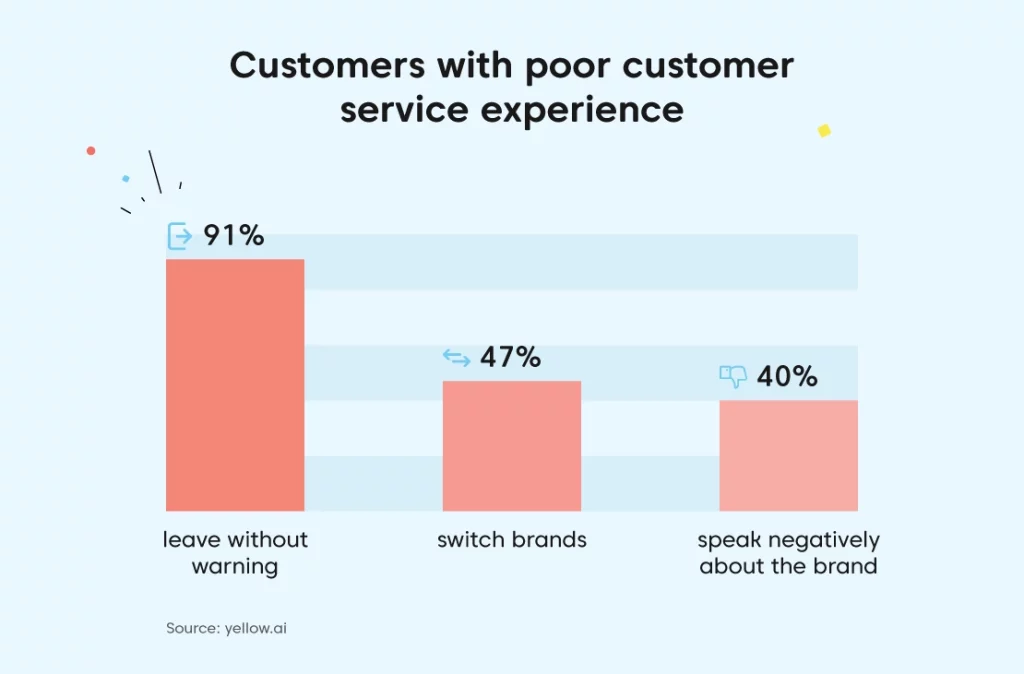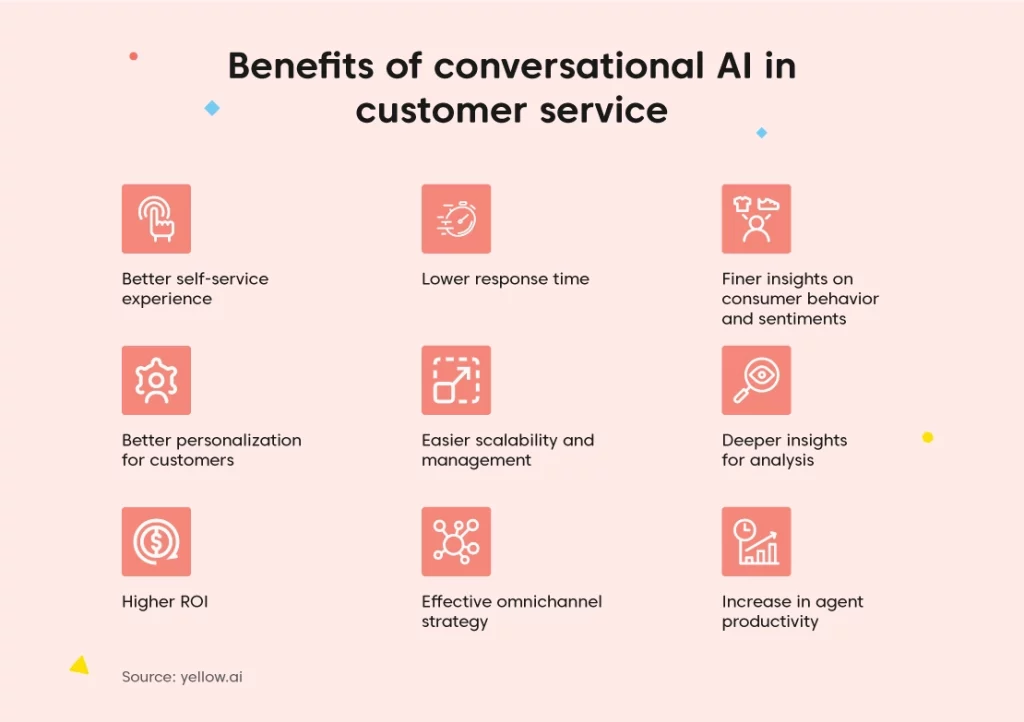We’re in 2023, and the stakes for exceptional customer service have never been higher. Did you know that according to a PwC study, a whopping 73% of all people point to customer experience as a crucial factor in their purchasing decisions? But wait, there’s more: Gartner predicts that by the end of this year, more than half of all customer service interactions will be automated to some degree.
Now, let’s bring two critical metrics into the mix: Customer Lifetime Value (CLV) and Customer Acquisition Cost (CAC). If you’re in the business game, you know that the higher the CLV and the lower the CAC, the better. But how do you achieve that nirvana-like state? You got it—Conversational AI. By making customer service faster, more efficient, and downright delightful, Conversational AI not only boosts your CLV but does it so cost-effectively that your CAC takes a nosedive.
So, what’s the secret sauce to meeting these sky-high customer expectations, optimizing CLV and CAC, and staying ahead of the curve? Drumroll, please… Conversational AI.
So if you’re an ambitious business leader eager to bring your company’s CX to the next level, stick around. This blog is your roadmap to understanding why conversational AI in customer service is not just essential but revolutionary.
And more importantly, why the time to act is NOW.
What is conversational AI?
Alright, let’s get down to brass tacks and talk about what Conversational AI actually is. Imagine walking into your favorite mom-and-pop store. You’re greeted by name, they know your usual order, and maybe even ask about your dog, Sparky! That’s personalized service at its finest. Now, what if we told you that Conversational AI could provide that same level of personalized, intuitive service, but digitally? Mind-blowing, right?
Conversational AI is the technology that powers those incredibly intelligent chatbots and virtual assistants you encounter on websites, messaging apps, and even on the phone. At its core, Conversational AI is about making machines talk like humans. And not just kind of conversation, though—we’re talking about contextual, meaningful, and interactive conversations.
So, how does it work? These chatbots and virtual assistants use a blend of natural language processing (NLP), machine learning, and good old data analytics to understand, process, and respond to human language. It’s like having a tireless, always-on-point customer service rep who doesn’t take coffee breaks or call in sick.
The result? Conversational AI enables businesses like yours to handle thousands of customer queries simultaneously, 24/7, in a manner that’s not just efficient but also impressively human-like. The technology has matured to the point where these AI-driven interactions can be as fruitful, if not more so, than those led by human agents.
And just like that, your business is up and running around the clock, providing spot-on customer service, closing deals, and let’s not forget, significantly optimizing those all-important CLV and CAC metrics.
The best part? Conversational AI is constantly learning, adapting, and improving. So the more your customers interact with it, the better it gets at delivering top-notch service.
How can conversational AI be used?
Wondering how to get the most bang for your buck with Conversational AI? The applications are far-reaching and can revamp not just customer service but multiple aspects of your business.
- Customer support: Conversational AI takes customer service to the next level by providing instant, 24/7 support, cutting down wait times, and boosting satisfaction.
- Sales and marketing: This technology can guide customers down the sales funnel effectively, offering personalized product suggestions and boosting conversions.
- Employee experience: Don’t overlook the internal benefits. Conversational AI can streamline HR processes, assist in training, and make information retrieval efficient for your team, improving employee satisfaction.
- Data gathering: Conversational AI is also a data goldmine. It captures key insights into customer behavior that can refine marketing strategies and product development.
- Personalization: Think targeted discounts and product recommendations. Conversational AI can personalize experiences based on individual behavior.
- Payment and transactions: For sectors like finance and retail, Conversational AI streamlines transactions, making payment processes swift and user-friendly.
- Accessibility and inclusivity: This technology makes services more accessible to people with disabilities, like the visually impaired, through voice-activated systems.

Benefits of conversational AI for customer service
You may be asking, “Sure, Conversational AI sounds good. But why should my business specifically invest in it for customer service?” The short answer: Because your competitors are likely already doing it, and your customers are starting to expect the enhanced, seamless omnichannel experience that that get out it, and soon will be demanding it. Here are a few top reasons why your business needs it:
1. Round-the-clock availability
Today’s consumers aren’t in the habit of waiting. They want fast, efficient, and personalized service. AI can deliver on these expectations 24/7, something that’s hard to do with human agents alone.
2. Seamless omnichannel CX
Conversational AI allows businesses to establish a coherent and effective omnichannel strategy. For example, imagine a customer starts a conversation with a chatbot on a company’s website to inquire about a product. Later, while scrolling through social media, the same customer has another question. They can pick up right where they left off in the conversation without having to reintroduce themselves or restate their initial inquiry. The chatbot could be programmed to remember the context and offer personalized recommendations, whether the customer interacts through Facebook Messenger, WhatsApp, or a company’s own mobile app. This cross-channel consistency not only elevates the brand experience but also allows for more fluid customer journeys.
3. Cost savings
Reducing the reliance on human agents for basic queries allows you to reallocate your resources to more complex and revenue-generating tasks. In fact, A study by IBM estimates that AI can handle more than 80% of all customer service inquiries, meaning you can scale your service offerings without dramatically increasing staffing costs.
4. Higher ROI
Conversational AI isn’t just a cost-saving measure; it’s a revenue generator. It can significantly drive up revenue by offering real-time, personalized product recommendations. For example, if a customer is shopping for a laptop, the chatbot can suggest relevant accessories or software, even offering limited-time discounts to encourage immediate purchase. This targeted upselling not only boosts sales but also enhances the customer experience, ultimately contributing to a higher customer lifetime value. It’s a win-win that positively impacts your bottom line.

5. Efficiency and scale
Humans can only do so much. AI doesn’t need lunch breaks and can handle multiple queries at once, allowing your business to scale customer service efforts without a corresponding jump in headcount or overhead.
6. Consistent and high quality service
Let’s be honest, even the best of us have off days, and can have a variability in their performance. AI doesn’t. According to a Forrester study, 66% of customers say valuing their time is the most important thing a company can do to provide good service. Conversational AI ensures consistent, error-free service, ensuring every customer interaction is up to the mark.
7. Proactive customer engagement
According to Accenture, 91% of consumers are more likely to shop with brands who recognize, remember, and provide them with relevant offers and recommendations. With conversational AI, you can initiate conversations with your customers based on their behavior or other triggers, and nudge them to providing an extra layer of service that’s often unexpected but appreciated.
8. Rich customer insights
Don’t fly blind. Conversational AI gives you rich data to understand customer behavior, preferences, and pain points. This kind of actionable intelligence is invaluable for tailoring products, services, and customer experiences.
9. Global reach
Got customers in different time zones? Language barriers? Conversational AI can communicate in multiple languages and operates around the clock, giving your business a global footprint.
10. Flexibility and adaptability
Market conditions and consumer needs are ever-changing. The beauty of Conversational AI is its adaptability. Update its algorithms based on new data or business strategies, and your bot evolves right along with your business needs.
Must read: 10 Top conversational AI platforms in 2024
Conversational AI use cases in customer service
If you’re still on the fence about Conversational AI, let’s drill down into some real-world applications that have moved the needle for businesses across sectors. Don’t think of AI as a faceless, emotionless robot; envision it as a multi-tool that can tackle an array of customer service tasks with precision and scale.
1. Virtual help desks
Look, no one likes waiting on hold. Virtual help desks operate around the clock, resolving customer issues at any hour. Imagine the peace of mind your customers get knowing they can reach out 24/7 and get an immediate response. Plus, these bots can handle tons of queries at the same time, which means quicker resolution and happier customers.
2. Automated upselling and cross-selling
Why stop at just satisfying your customers when you can also increase your sales? Conversational AI identifies opportunities for upselling and cross-selling, presenting customers with products they’re likely to be interested in. Now that’s smart business.
3. Order tracking
No one likes being in the dark about where their stuff is. With Conversational AI, customers can get real-time updates on their orders. No more hunting for tracking numbers or waiting on emails. It’s a win-win for both your customer service team and your customers.
4. Personalized recommendations
Who doesn’t love a personalized experience? Conversational AI can tap into customer data and prior interactions to offer personalized product suggestions. It’s like having a super-efficient sales assistant who knows each customer by name and preference. And guess what? This translates into higher conversions and more sales.
5. Feedback collection
Feedback is gold, but let’s face it, collecting it can be a drag. Your AI pal here makes it super easy by asking for reviews or ratings at just the right moment. You get real-time, actionable insights, straight from the horse’s mouth.
6. Employee onboarding
Think beyond just customer interaction—your employees will thank you, too. New hires often have the same set of questions during onboarding. A chatbot can handle these FAQs, freeing up your HR team to focus on more nuanced tasks.
7. Billing and payments
Numbers don’t lie, and neither should your billing process. Conversational AI makes billing and payments a breeze by automating invoices and sending timely reminders. Less stress, fewer errors, and more happy customers—what’s not to like?
8. Emergency response
When the clock’s ticking, you don’t want to leave your customers hanging. Conversational AI can offer immediate assistance in emergencies, giving crucial guidance while collecting essential data for any necessary follow-up.
9. Real-time analytics
Data is the new oil, and real-time analytics are your drilling rig. Conversational AI provides insights on-the-fly, helping you make snap decisions that could be game-changers for your business.
How to leverage conversational AI in customer service for the best results?
To maximize the effectiveness of conversational AI in customer service, there are a few key strategies to dial in:
Pick your platform wisely: Every chatbot platform has its own set of bells and whistles. You’ll want to choose one that brings the heat—think robust natural language understanding, seamless integration options, and scalability to grow with you.
Did you you know: Yellow.ai’s Dynamic Automation Platform (DAP) is fluent in 135+ languages, is pre-trained on billions of conversations every quarter, and offers 150+ prebuilt templates and 100+ plug & play integrations? Book a demo
Fine-tune your bot to your brand: Forget one-size-fits-all. Your chatbot needs to resonate with your brand’s unique vibe. Customize its dialogue and behavior so your customers feel like they’re having a one-on-one with your brand, not a generic bot.
Keep it learning, keep it real: Utilize machine learning and customer interaction data to up your chatbot’s game continuously. Frequent updates based on actual customer interactions will make your bot not just a know-it-all, but a learn-it-all.
Smooth systems integration: Your chatbot should slide effortlessly into your existing tech stack. That means working hand-in-hand with your CRM, inventory systems, and any other platforms your business relies on. This isn’t just great for your customers; it’s a win for your support team too.
Got metrics? Use ‘Em: Measuring success is more than counting high-fives at the end of the day. Keep an eye on concrete metrics like customer satisfaction scores, time saved, and, yeah, revenue bumps. These numbers will tell you how well the bot is doing and where you can fine-tune.
Follow these strategies with due diligence, and you’ll be well on your way to harnessing the full potential of conversational AI for your customer service.
Future of AI in customer service
As we look toward the future, advanced AI technologies like Generative AI are set to redefine the capabilities of conversational bots. Imagine a chatbot that doesn’t just respond to queries but can generate original, context-rich dialogue based on previous interactions and learned customer preferences. In fact, generative AI models like GPT-3 and 4 are already making waves in the conversational AI space.
What sets them apart is their ability to understand context, generate human-like responses, and even carry out tasks across multiple turns of conversation. In essence, they bring a level of sophistication to customer interactions that was previously unattainable.
What’s exciting is that this is just the beginning. As generative AI continues to evolve, we can expect even more advanced capabilities—like deeper contextual understanding and real-time adaptation to customer mood and preferences. This isn’t just a future possibility; it’s actively shaping the state of conversational AI today, challenging our expectations and redefining what’s possible in customer service.
Conversational AI in customer service – FAQs
Why should businesses implement conversational AI in customer service?
Truth be told, if you’re in business today, customer experience is your battleground. Implementing conversational AI in customer service can significantly improve customer experience, streamline operations, and cut costs. From offering 24/7 support to handling multiple queries simultaneously, AI-powered bots empower businesses to offer high-quality, consistent service. Moreover, it aids in lead generation and provides actionable analytics, helping businesses make data-driven decisions.
Can conversational AI replace human customer service representatives?
Although, next-gen conversational AI are a game-changer for the customer service landscape, but it’s not about replacing humans. Instead, it’s about empowering them. While these advanced AI systems are capable of handling complex scenarios and queries, they’re at their best when they work in tandem with human customer service agents. The result is a more efficient operation that delivers customer experience excellence through the best of both worlds: AI and human ingenuity.
What channels can conversational AI be deployed on for customer service?
Oh, it’s multi-talented! We’re talking websites, mobile apps, social media platforms, and even voice-activated devices—you name it. It’s like having a top-notch customer service rep who’s everywhere your customers are, making their lives easier, and boosting their love for your brand.
Can conversational AI understand and respond accurately to customer queries?
Advanced conversational AI systems don’t just leverage Natural Language Processing (NLP) for understanding literal phrases; they’re also highly empathetic and context-aware. This means they can interpret the tone, mood, and urgency behind customer queries, adjusting their responses accordingly. By understanding both the content and the context of interactions, they deliver not just accurate, but also emotionally resonant responses. Continuous machine learning enables these systems to adapt over time, becoming even more skilled at navigating the complexities of human conversation and changing customer behaviors. So, it’s not just about understanding what is being asked, but also about grasping the sentiment and situation in which the query is being made.
How can conversational AI provide a personalized customer experience?
These aren’t your grandma’s chatbots; they’re like personal shoppers or concierges for your customers. Using data and a sprinkle of machine learning magic, they can offer personalized recommendations, remember past interactions, and even anticipate needs. From personalized product recommendations to remembering past interactions, these bots deliver highly personalized experiences. This personalization can lead to higher conversion rates and increased customer loyalty.
Is conversational AI capable of handling complex customer issues?
Absolutely! Next-gen conversational AI systems are now much more capable and can indeed handle complex customer issues that were once reserved for human agents. Utilizing advanced algorithms, machine learning, and a rich understanding of both language and context, these systems can solve intricate problems in areas like troubleshooting, personalized recommendations, and even interpret multifaceted customer sentiments. They can engage in dialogue that involves multiple turns and subjects, and they can integrate with other business systems to fetch or update real-time information. In many scenarios, they offer solutions that are indistinguishable from what a trained human agent would provide, thereby delivering customer experience excellence.
Can conversational AI integrate with existing customer service systems?
Absolutely. Modern conversational AI solutions are designed to integrate seamlessly with existing CRM systems, inventory databases, and other key operational platforms, ensuring a smooth, streamlined experience for both customers and support agents.
Yellow.ai for example offers 100+ plug-and-play integrations for your CRMs, knowledge management hubs, payment gateways, ecommerce sites, voice systems and more.
Yellow.ai and conversational AI
Yellow.ai is the world’s leading enterprise-grade conversational AI provider serving 1000+ enterprises world wide win the customer support game powered by next-gen automation solutions. With our Conversational Service Cloud suite you can:
- 60% automation within 30 days
- 40% increase in CSAT
- 35+ channels across text and voice
- Support for 135+ languages
Talk to our experts to learn more about how we can help you supercharge your customer service!
Your path to superior customer service begins here





















